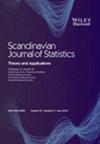基于回归的网络流和内矩阵重构
IF 1
4区 数学
Q3 STATISTICS & PROBABILITY
引用次数: 0
摘要
网络或矩阵重构是一个普遍问题,如果矩阵的行列和是给定的,则需要根据汇总信息对矩阵条目进行预测。在本文中,我们证明了从迭代比例拟合过程(IPFP)或等价最大熵(ME)中获得的预测结果可以通过依赖于增强拉格朗日优化的受限极大似然估计来获得。基于这种等价性,我们将以行和列总和为条件的网络重构框架扩展到回归,从而可以纳入外生协变量和基于引导的不确定性量化。更具体地说,回归模型的平均值会导致观察到的行和列边际。为了举例说明这种方法,我们进行了模拟研究,并调查了国际清算银行提供的银行间借贷数据。该数据集提供了真实网络的全部知识,因此适用于评估我们方法的预测结果。结果表明,加入外生信息后,我们的预测结果在误差方面更胜一筹。本文章由计算机程序翻译,如有差异,请以英文原文为准。
Regression‐based network‐flow and inner‐matrix reconstruction
Network or matrix reconstruction is a general problem that occurs if the row‐ and column sums of a matrix are given, and the matrix entries need to be predicted conditional on the aggregated information. In this paper, we show that the predictions obtained from the iterative proportional fitting procedure (IPFP) or equivalently maximum entropy (ME) can be obtained by restricted maximum likelihood estimation relying on augmented Lagrangian optimization. Based on this equivalence, we extend the framework of network reconstruction, conditional on row and column sums, toward regression, which allows the inclusion of exogenous covariates and bootstrap‐based uncertainty quantification. More specifically, the mean of the regression model leads to the observed row and column margins. To exemplify the approach, we provide a simulation study and investigate interbank lending data, provided by the Bank for International Settlement. This dataset provides full knowledge of the real network and is, therefore, suitable to evaluate the predictions of our approach. It is shown that the inclusion of exogenous information leads to superior predictions in terms of and errors.
求助全文
通过发布文献求助,成功后即可免费获取论文全文。
去求助
来源期刊

Scandinavian Journal of Statistics
数学-统计学与概率论
CiteScore
1.80
自引率
0.00%
发文量
61
审稿时长
6-12 weeks
期刊介绍:
The Scandinavian Journal of Statistics is internationally recognised as one of the leading statistical journals in the world. It was founded in 1974 by four Scandinavian statistical societies. Today more than eighty per cent of the manuscripts are submitted from outside Scandinavia.
It is an international journal devoted to reporting significant and innovative original contributions to statistical methodology, both theory and applications.
The journal specializes in statistical modelling showing particular appreciation of the underlying substantive research problems.
The emergence of specialized methods for analysing longitudinal and spatial data is just one example of an area of important methodological development in which the Scandinavian Journal of Statistics has a particular niche.
 求助内容:
求助内容: 应助结果提醒方式:
应助结果提醒方式:


